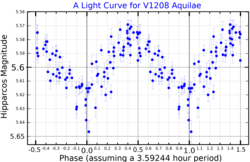Astronomy:28 Aquilae
| Observation data Equinox J2000.0]] (ICRS) | |
|---|---|
| Constellation | Aquila |
| Right ascension | 19h 19m 39.34802s[2] |
| Declination | +12° 22′ 28.8457″[2] |
| Apparent magnitude (V) | 5.51 - 5.56[3] |
| Characteristics | |
| Spectral type | F0 III[4] |
| U−B color index | +0.182[5] |
| B−V color index | +0.257[5] |
| Variable type | δ Sct[3] |
| Astrometry | |
| Radial velocity (Rv) | +4.36[4] km/s |
| Proper motion (μ) | RA: +4.249[2] mas/yr Dec.: +16.199[2] mas/yr |
| Parallax (π) | 9.5836 ± 0.0768[2] mas |
| Distance | 340 ± 3 ly (104.3 ± 0.8 pc) |
| Absolute magnitude (MV) | +0.46[6] |
| Details | |
| Mass | 2.4[2] M☉ |
| Radius | 4.8[2] R☉ |
| Luminosity | 54.20[6] L☉ |
| Surface gravity (log g) | 3.41[7] cgs |
| Temperature | 7,250[4] K |
| Metallicity [Fe/H] | −0.16[4] dex |
| Rotational velocity (v sin i) | 57[8] km/s |
| Age | 655[2] Myr |
| Other designations | |
| Database references | |
| SIMBAD | data |
28 Aquilae, abbreviated 28 Aql, is a star in the equatorial constellation of Aquila. 28 Aquilae is its Flamsteed designation though it also bears the Bayer designation A Aquilae, and the variable star designation V1208 Aquilae. It has an apparent visual magnitude is 5.5,[4] making this a faint star that requires dark suburban skies to view (according to the Bortle Dark-Sky Scale). The annual parallax shift of 9.6 mas means this star is located at a distance of approximately 340 light-years (100 parsecs) from Earth.
The spectrum of this star matches a stellar classification of F0 III.[4] Despite consistent spectral classifications as a giant star,[10] models show that it is just reaching the end of its main sequence lifetime at an age of 655 million years.[2]
The variability of 28 Aquilae was discovered by Michel Breger in 1969. It was revealed to be a Delta Scuti-type pulsating variable star with at least two periods of pulsation. The known periods have frequencies of 6.68 and 7.12 cycles per day.[11] The outer atmosphere has an effective temperature of 7,250 K,[4] which lies in the range of a yellow-white hued F-type star.[12]
References
- ↑ Light Curve, ESA, https://www.cosmos.esa.int/web/hipparcos/java-tools/light-curve, retrieved 17 February 2022.
- ↑ Jump up to: 2.0 2.1 2.2 2.3 2.4 2.5 2.6 2.7 2.8 Vallenari, A. et al. (2022). "Gaia Data Release 3. Summary of the content and survey properties". Astronomy & Astrophysics. doi:10.1051/0004-6361/202243940 Gaia DR3 record for this source at VizieR.
- ↑ Jump up to: 3.0 3.1 Samus, N. N. et al. (2017), "General Catalogue of Variable Stars", Astronomy Reports, 5.1 61 (1): 80–88, doi:10.1134/S1063772917010085, Bibcode: 2017ARep...61...80S.
- ↑ Jump up to: 4.0 4.1 4.2 4.3 4.4 4.5 4.6 Luck, R. Earle; Heiter, Ulrike (June 2007), "Giants in the Local Region", The Astronomical Journal 133 (6): 2464–2486, doi:10.1086/513194, Bibcode: 2007AJ....133.2464L.
- ↑ Jump up to: 5.0 5.1 Breger, M. (March 1968), "UBV and narrow-band UVBY photometry of bright stars", Astronomical Journal 73: 84–85, doi:10.1086/110602, Bibcode: 1968AJ.....73...84B.
- ↑ Jump up to: 6.0 6.1 Anderson, E.; Francis, Ch. (2012), "XHIP: An extended hipparcos compilation", Astronomy Letters 38 (5): 331, doi:10.1134/S1063773712050015, Bibcode: 2012AstL...38..331A.
- ↑ Soubiran, C. et al. (June 2010), "The PASTEL catalogue of stellar parameters", Astronomy and Astrophysics 515: A111, doi:10.1051/0004-6361/201014247, Bibcode: 2010A&A...515A.111S.
- ↑ Royer, F. et al. (October 2002), "Rotational velocities of A-type stars in the northern hemisphere. II. Measurement of v sin i", Astronomy and Astrophysics 393: 897–911, doi:10.1051/0004-6361:20020943, Bibcode: 2002A&A...393..897R.
- ↑ "* 28 Aql". SIMBAD. Centre de données astronomiques de Strasbourg. http://simbad.u-strasbg.fr/simbad/sim-basic?Ident=%2A+28+Aql.
- ↑ Skiff, B. A. (2014), "VizieR Online Data Catalog: Catalogue of Stellar Spectral Classifications (Skiff, 2009–2016)", VizieR On-line Data Catalog, Bibcode: 2014yCat....1.2023S.
- ↑ Dall, T. H.; Frandsen, S. (May 2002), "Mode characterisation in delta Scuti stars. I. rho Pup, GN And, V1208 Aql and AV Cet", Astronomy and Astrophysics 386 (3): 964–970, doi:10.1051/0004-6361:20020357, Bibcode: 2002A&A...386..964D.
- ↑ "The Colour of Stars", Australia Telescope, Outreach and Education (Commonwealth Scientific and Industrial Research Organisation), December 21, 2004, http://outreach.atnf.csiro.au/education/senior/astrophysics/photometry_colour.html, retrieved 2012-01-16.
External links
 |


